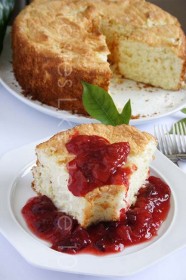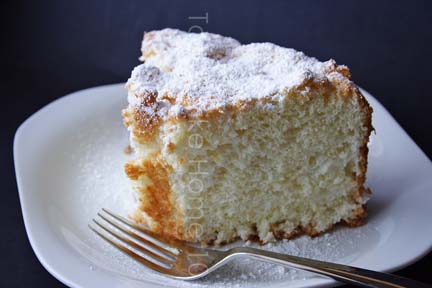If this week’s headline seems confusing, it’s because people often think of a Sponge Cake and a Pound Cake as one and the same; they aren’t. The two cakes are different, in many ways.
 In Guyana we refer to the Pound Cake as Sponge Cake. I grew up hearing even my mom referring to the Pound Cake as a Sponge Cake. Actually, the Pound Cake is my mom’s absolute favourite cake. Throughout the year this was the only kind of cake she’d make. Apart from not personally being a big fan of the Pound Cake, I hated when we (my sister and I) would have to take turns creaming the butter and sugar for mommy’s precious Sponge Cake! But I digress. Forgive me; I had to get that out.
In Guyana we refer to the Pound Cake as Sponge Cake. I grew up hearing even my mom referring to the Pound Cake as a Sponge Cake. Actually, the Pound Cake is my mom’s absolute favourite cake. Throughout the year this was the only kind of cake she’d make. Apart from not personally being a big fan of the Pound Cake, I hated when we (my sister and I) would have to take turns creaming the butter and sugar for mommy’s precious Sponge Cake! But I digress. Forgive me; I had to get that out.
I often get requests from my fellow Guyanese, particularly those living abroad for the recipe for “Guyanese Sponge Cake”. Read Pound Cake. I usually take the opportunity each time to clarify that the “Guyanese Sponge Cake” is really a Pound Cake.
There are two types of raised cakes – foam cakes and butter cakes. Foam cakes have a high egg to flour ratio and are leavened by the air beaten into whole eggs or egg whites. Butter cakes on the other hand contain fat from butter, margarine or shortening and they rely on leavening agents such as baking powder or baking soda. The Sponge Cake is a foam cake. The Pound Cake is a butter cake.
Sponge Cakes are made with basically three main ingredients – eggs, sugar and flour. They are light and airy as a result of the air beaten into the separated egg yolks and egg whites. Once baked, Sponge Cakes are versatile, they can be eaten as is or with fruit, fruit sauces, jams, preserves, whipped cream etc. They are favourites to be used in many desserts that call for cakes as their base; this is so because the big, fluffy cake can soak up anything, just like a sponge!
Sponge Cakes can be tricky to make but they are not as scary to attempt as some people will tell you. Here’s what you need to know before setting out to make a Sponge Cake.

The ingredients, particularly the eggs have to be at the right temperature. Here’s a tip, once the eggs come up to room temperature, let them sit for another 30 minutes before using them. The warmer the eggs, the higher will be the volume when beaten.
As usual, when baking, measure all your ingredients and have them lined up and at hand.
A hand-mixer would be an ideal tool but if you don’t have one, get a whisk and be prepared to employ some elbow grease to beat the yolks and whites.
A rubber spatula or a large balloon-whisk would be best for folding in the ingredients.
Know how to fold ingredients, and in this case, you will need to do so with a light, gentle touch. The purpose of folding ingredients is to combine them without knocking the air out of them. To fold ingredients, place your spatula in the middle of the bowl and then in one seamless motion, pull the spatula towards the side and along the base and fold the mixture onto itself. Rotate the bowl at 90-degrees and repeat the action until the ingredients are just combined. You do not want to over mix.
Many recipes suggest using an ungreased pan – this encourages the batter to really climb up the sides of the pan adding extra volume, but if you like, give a light spray to your pan. Personally, I prefer to use an ungreased non-stick pan
Once the cake is baked, it has to cool for at least an hour before unmoulding it; the pan is turned upside down as the cake cools, this is to ensure that the cake does not fall back onto itself and become heavy.
When the cake is cooled and unmoulded, slice and serve with fruit, a drizzle of syrup or a dusting of confectioner’s sugar (icing sugar). And there you have it – Sponge Cake.
Cynthia
Cynthia@tasteslikehome.org
www.tasteslikehome.org
Sponge Cake
Ingredients
6 large eggs, room temperature or warmer
1 cup white sugar, divided
1 teaspoon vanilla essence
1 tablespoon tap water
1 teaspoon lemon or lime zest
1 cup all-purpose flour
¾ teaspoon cream of tartar
Equipment
2 large bowls
1 medium bowl
1 sieve
1 hand mixer or whisk
1 rubber spatula or balloon-like whisk
1 (10-inch) tube cake pan ungreased, or a round cake pan lined with parchment paper at the bottom only
If using a tube pan that does not have feet, you will need a bowl or 4 cans of any canned item
1 wire rack
Directions
1. Preheat oven to 350 degrees with rack in the middle.
2. Separate the eggs – whites in one bowl and yolks in another.
3. Add flour and ¼ cup sugar and sieve into medium bowl; set aside.
4. Set aside ¼ cup sugar to beat into egg whites.
5. Add ½ cup sugar to bowl with yolks and beat on high for 5 minutes. The batter should be thick and pale. Add in the essence, water and zest and beat for another 30 – 40 seconds to incorporate. Once done, the batter when lifted should fall back like ribbons. Set aside.
6. Remove the beaters from your mixer and attach the whisk to beat the egg whites. Start on low or medium whisking the egg whites until they become foamy about 1 – 2 minutes. Add the cream of tartar, raise the speed to high and continue beating the egg whites. When the whites form soft peaks about 3 – 4 minutes into the beating, gradually add the sugar and continue to beat the whites until they become stiff and look glossy and shiny. The entire beating of the egg whites should take about 5 minutes, more or less depending on your mixer.
7. Take your flour-sugar mixture, add it to the sieve again and this time, sieve it into the yolk batter. Immediately following this, take about 1/3 of the beaten egg whites and quickly, carefully and gently, fold in the ingredients. Do not over mix!
8. Now add the remaining eggs whites and fold in gently until just combined. Do not over mix!
9. Transfer the batter to the cake pan and place in the oven. Bake for 30 – 35 minutes or until a skewer inserted comes out clean.
10. Remove pan with cake from oven. If using a traditional baking pan, as soon as the cake comes out of the oven, take a knife and run it around the insides of the pan to unmould the cake, then take the wire rack and invert the cake onto it. Remove the parchment paper, flip the cake cover and let cool on the wire rack for at least 1 hour before cutting in to it.
11. If however, you are using a tube pan, invert the pan on to a bowl that’s turned upside down or invert the pan on top of the 4 cans placed in a square, 5 inches apart from each other. Let cool for an hour before unmoulding.
12. Serve as is, with a dusting of icing sugar, with fresh fruit, fruit compote, fruit sauce, jam, flavoured syrup or whipped cream.
Notes
● The cake can be used for any dessert that calls for a cake as the base.
● This cake is best used within 2 days; it can be stored frozen for a couple of weeks.
● This is the American-style sponge cake. For the European version, when the cake is cool, drizzle it with syrup and let it sit at room temperature at least for a day before cutting in to it. Be careful not to add too much syrup, as that will cause the cake to become soggy.







